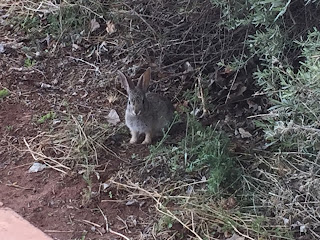We stayed at a KOA in Cascade Lakes, a nice campground peppered with pines and sequoias.
It was here that we saw the cute ladybug rig parked next to us. The back of the ladybug opened up to reveal a sizable storage area that included a microwave oven. They had a TV inside as well.
They let me look inside their set up. One guy had a king size bed and the other had a queen size bed, but the tent design gave them a large, full-height area for dressing or setting up a table. All their gear was stowed in the bottom of the trailer. Very compact and convenient.
The Bonneville Dam was very interesting. Located just below Cascade falls, a treacherous rapids on the river, it was the first of a series of dams built on the Columbia River in the 1930's and was part of Roosevelt's plan for recovery from the Great Depression. When he campaigned in Oregon, he promised to build a dam to 1) assist in shipping along the Columbia, and 2) put people to work. The promise of cheap electricity did little to win over skeptical farmers who doubted the dam was necessary. Local Indians decried the loss of the environment and the damage to the salmon migration. But the dam was built.
It was built with a lock to move boats up and down the river. Electricity was provided for everyone for the same cost regardless of how far they lived from the dam, which made it affordable. And by WWII it needed to be expanded to accommodate all the energy local factories needed to support the war effort.
Those worried about the salmon had valid concerns, but the dam was designed to help the fish migrate upstream in the spring. Fish Ladders were built along side the dam. The waterflow was controlled through the ladders to match what salmon would expect. By regulating waterflow, salmon would be drawn to the ladders and could navigate upstream.
This is a Fish Ladder! These 'steps' also had openings in the bottom that fish could swim through to get upstream. Some fish jump the ladder, but most swim.
Inside this door is a "Fish Counter". The fish are counted daily during migration season. The room is staffed for 16 hours a day. A video camera records the fish at night. A log is posted on the door of how many and what species of fish went through the ladders! (I'm glad I don't have to do that!!)
We could look into the Fish Counter Room through a small window and see the fish there as well.
The Fish Hatchery is one of the most beautiful I've ever been to. It was located next to the Bonneville Dam.
A sculpture near the entrance
 |
| Trout Ponds |
The hatchery raises trout and sturgeon to be released into the river. As an easterner, the Rainbow trout in the west are huge!
 |
| Western Rainbow Trout |
But if I thought the trout were big, the sturgeon were amazing!
We could view the sturgeon in the pond from a platform above the water, or through windows in the viewing house.
Sturgeon are ancient fish. They have been here since pre-historic times and live to be 50-60 years old. They are 15-20 years old before they have their first spawn. They have no scales, but do have five rows of armored plates called scutes. They average 7-10' but can grow much larger. |
| Sturgeon Pond |
After we left the Fish Hatchery, we drove scenic Rte 30.
Historic Rte 30 between Bonneville and Vista House is a lovely drive with towering waterfalls.
Well-named, this falls looks just like a flowing horse tail.
 |
| Horsetail Falls |
Wahkeena Falls. The bridge in the trees is only half way up. The falls start at the top of the cliff.
Multnomah Falls is the biggest and the best known. It is just beautiful.
Latourell Falls.
Long before the National Scenic Area Act of 1986, advocates recognized the significance of this area.
Upon completion of the historic Columbia River Highway in 1915, generous landowners donated property to create scenic retreats along the route. Most of the most spectacular features were donated by philanthropists or civic groups. We are the recipients of their gift, today.
We followed Historic Rte 30 to a place called Crown Point Vista House, situated high on a promontory along the river. This was originally a rest stop for cars that had made it up the steep inclines and needed that stop for the engine to cool off.
As many pictures as I took that day, I can't believe I didn't take one of the Vista House. This is an image I found online. Truthfully, the first thing we noticed up there was that THE WIND BLOWS! When Larry opened the car door, the wind ripped it out of his hand. From then on, our focus was just holding on to our cameras and each other. The wind was blowing 40 mph, and gusting up to 45 mph. We were told they closed the building when winds hit 50 mph. Winds of 100 mph have been recorded. No Thanks!!
We braced ourselves against the wind and managed to take a few pictures of the view, which was a pretty good one.
Inside the house I was asked to move off a section of the floor, because it was an elevator, and was being used to bring someone upstairs!
 |
| Elevator Rising |

























































